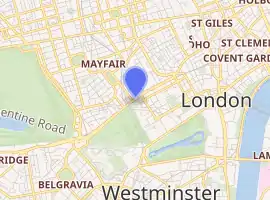Walsingham House
The Walsingham House or Walsingham House Hotel was located at 150-4 Piccadilly[1] on the site of what is now The Ritz Hotel, London[2] and was adjacent to the Bath Hotel.[3] The Ritz's financial backers began negotiations in 1901 and purchased the Walsingham simultaneously with the Bath Hotel.[4] Though the Walsingham was of fairly new construction, they determined it was too "inelegant" and demolished the building.[5] One of the considerations that made the transaction appealing to the city was that they would be able to widen Piccadilly when the Walsingham and Bath Hotels were demolished.[6]
| Walsingham House | |
|---|---|
 The hotel circa 1896 | |

| |
| General information | |
| Location | 150-154 Piccadilly, London, United Kingdom |
| Coordinates | 51°30′26″N 0°08′30″W |
| Construction started | 1887 |
| Demolished | 1904 |
History
An 1869-1874 map of the area showed the Bath Hotel on the corner of Arlington Street and next to it a string of small businesses—a coach builder, coal merchant, stationer and Cockburn’s spirits. These were purchased in 1886 and demolished by[7] Lord Walsingham[8] to create the Walsingham House, luxury residential mansion flats, fully staffed and with restaurant facilities.[9] Lord Walsingham had the lavish accommodations built in 1887,[8] by the architect C W Stephens.[10] The eight-storey, red-brick building, designed by Alfred Burr,[7] featured flats which accommodated six bedrooms with en-suite bathrooms, each containing 12,323sq ft of living space.[8] The construction was completed in 1888.[7] Around the turn of the century, the residential mansion-flat concept was transitioned to smaller hotel suites.[11]

One of its early residents was Benoît-Constant Coquelin who carried on correspondence with Henry Irving[12] and Lillie Langtry from his residence there.[13] In 1898, the Hotel opened a new dining room[14] which was in the house which the Isthmian Club operated for many years[15] at 105 Piccadilly.[16] Lord Walsingham hired artist Cesare Formilli to complete the decoration of the new dining room, based upon designs that had been presented the previous year at the Paris Salon. Formilli selected the interior furnishings specifically for the room and surrounded it with columns featuring bas-reliefs of dancing girls. On the walls and ceilings were nine frescos, featuring hunting and fishing scenes.[17]
According to the tax record description of the property, it was composed of two blocks of buildings, one fronting Piccadilly and the other fronting Arlington. There were two separate entrances and 1/10th of the building was occupied by Lord Walsingham and his servants as a private residence. The remaining building consisted of Block A on Piccadilly and Block B on Arlington, which shared between them staircases and elevators. Block A contained six stories with an attic above. Each floor was accessed by a front staircase for residents and guests and a servant's staircase. On each landing were corridors from where one gained access to the chambers. Each suite featured an entry room, so that the private living chambers were not exposed to anyone entering the unit. The floor arrangement was: 1st floor 8 bedrooms and 9 strong rooms divided amongst 6 chambers, 2nd floor 8 chambers each with a single bedroom and strong room, 3rd floor 10 chambers, 4th floor 12 chambers, 5th floor 10 chambers and 6th floor 9 chambers (6 of which were used as servants' bedrooms). Block B on Arlington was smaller and had 3 chambers on each of four floors and on the fifth floor, 2 bedrooms for servants.[18]
The building was demolished in 1904[3] to make way for the Ritz Hotel.
References
- "A New Hotel In Piccadilly". HathiTrust. London, England: The Builder. 15 November 1902. p. 437. Retrieved 27 June 2015.
- "History The Ritz London. A Rich History". The Ritz London. The Ritz London. Retrieved 25 June 2015.
- Macqueen-Pope, Walter James (1972). Goodbye Piccadilly (2 ed.). Newton Abbot: David and Charles. p. 119. ISBN 0-7153-5544-9. Retrieved 26 June 2015.
- "To the Editor of the Times". The Times. London, England. 20 September 1901. p. 2. Retrieved 26 June 2015 – via Newspapers.com.

- Watkin, David (1984). Grand hotel: the Golden age of palace hotels : an architectural and social history (1. publ. ed.). New York: Vendome Press. p. 22. ISBN 978-0-865-65040-4.
- "Carlton Hotel". The Times. London, England. 30 October 1902. p. 14. Retrieved 26 June 2015 – via Newspapers.com.

- Burland, J. B.; Standing, J. R.; Jardine, F. M. (2001). Building response to tunnelling : case studies from construction of the Jubilee Line Extension, London. Volume 1, Projects and methods / editors, J.B. Burland, J.R. Standing, F.M. Jardine (1. publ. ed.). London: Thomas Telford. ISBN 0-7277-3017-7. Retrieved 27 June 2015.
- "Cheshire House 66A Eaton Square, and 52 Eaton Mews West, SWI". Country Life. 196: 105. 2002. Retrieved 26 June 2015.
- "The Walsingham House". The Times. London, England. 12 December 1889. p. 15. Retrieved 26 June 2015 – via Newspapers.com.

- "Walsingham House Hotel, Piccadilly". Viewfinder Historic England. London, England: Historic England. Retrieved 26 June 2015.
- "Knightsbridge North Side: Parkside to Albert Gate Court, West of Albert Gate". British History Online. London, England: University of London. Retrieved 26 June 2015.
- "Henry Irving 1838-1905 correspondence". Henry Irving. London, England: Henry Irving Foundation. Retrieved 26 June 2015.
- Langtry, Lillie (2005). The days I knew. North Hollywood, California: Panoply Publications. p. 110. ISBN 1-886571-13-9. Retrieved 26 June 2015.
- "Walsington House Hotel". The Times. London, England. 21 October 1898. p. 2. Retrieved 26 June 2015 – via Newspapers.com.

- Jackson, Lee. "Chapter XLV The Walsingham House (Piccadilly)". Victorian London. Victorian London. Retrieved 26 June 2015.
- Jackson, Lee. "Victorian London - Entertainment and Recreation - Clubs - Isthmian Club". Victorian London. Victorian London. Retrieved 26 June 2015.
- "Some Frescoes by Cesare Formilli". The Artist. New York, New York: Truslove Hanson & Comba Ltd. v.25-26: 23–25. 1899–1900. Retrieved 27 June 2015.
- Reports of Tax Cases: Volume III, 1890—1898. London, England: Board of Inland Revenue. 1899. pp. 247–250. Retrieved 27 June 2015.